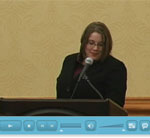Halifax Job Search Strategies Forum Report
How to be a Self-Advocate
| Video |
 |
Sarah Stonier, Student, University of New Brunswick
In junior high school, Sarah Stonier was placed in a severe learning disability program after being diagnosed with dysgraphia, which causes problems with reading and motor coordination. In public school she used her disability as an excuse, she said.
“‘I can’t’ became an excuse for everything,” she said. With the help of teachers she eventually learned to overcome her disability. “I proved I could do something if I tried.”
In 2005, Stonier was accepted into University of New Brunswick (UNB) with an entrance scholarship at its satellite campus in Bathurst. She recently finished a contract at Independent Living Canada, where she has been offered another contract.
“The first step in being a self-advocate is knowing how to explain yourself to others,” she said. Disabled students have help from professors, counsellors, and on-campus groups, but those sources of help are not available in the working world.
Recognize strengths and adapt to weaknesses, said Stonier. Solving problems is her greatest strength, and her weaknesses include poor depth perception, spelling, and motor abilities.
“I know what works and doesn’t work for me.” She suggested participants use the way they have adapted to home life as a model for adapting to the workplace.
Stonier chose to work at a hospital that makes extensive use of computers to help with her spelling. She uses a PDA for spelling and medication lookup. Rather than working on a busy and acute hospital floor, she works on slower-paced medical or rehab floors.
She identified the five steps for self-advocacy:
- Introduce yourself.
- Explain your disability.
- Explain your strengths and weaknesses.
- Explain the adaptations and accommodations you need.
- Know your expectations and accomplishments.
Keep an open mind, be ready to answer a lot of questions and prepare for varied responses, said Stonier. Some people may be afraid to ask questions about the disability. While employees may not have a legal obligation to reveal a disability, they might have a moral or ethical obligation to do so, she said. In her case, it might be in the best interest of the job-seeker to do so.
Stonier said some professors have over- or under-accommodated for her disability. Some instructors put her into the category of a bad nurse.
“Another instructor actually said I would end up killing someone.” Despite her frustrations, she said “the reward comes from patients who thank you and give you a hug and say, ‘Thank you for being my nurse today.’”
There are certain ways to ask for help with a disability. Stonier suggests using phrases emphasizing the pronoun “I” rather than “you” or “me.” It is better to say, “I am having trouble with this. Could I get your help?” than “Could you please help me?” Ask for help only after trying something once without success, said Stonier. A task might need to be accomplished quickly, in which case a disabled worker could ask for help and then practice later.

 Quick Question:
Quick Question:

